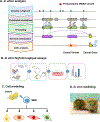Pregnancy, preeclampsia and maternal aging: From epidemiology to functional genomics
- PMID: 34871806
- PMCID: PMC8827396
- DOI: 10.1016/j.arr.2021.101535
Pregnancy, preeclampsia and maternal aging: From epidemiology to functional genomics
Abstract
Women live longer than men but experience greater disability and a longer period of illness as they age. Despite clear sex differences in aging, the impact of pregnancy and its complications, such as preeclampsia, on aging is an underexplored area of geroscience. This review summarizes our current knowledge about the complex links between pregnancy and age-related diseases, including evidence from epidemiology, clinical research, and genetics. We discuss the relationship between normal and pathological pregnancy and maternal aging, using preeclampsia as a primary example. We review the results of human genetics studies of preeclampsia, including genome wide association studies (GWAS), and attempted to catalog genes involved in preeclampsia as a gateway to mechanisms underlying an increased risk of later life cardio- and neuro- vascular events. Lastly, we discuss challenges in interpreting the GWAS of preeclampsia and provide a functional genomics framework for future research needed to fully realize the promise of GWAS in identifying targets for geroprotective prevention and therapeutics against preeclampsia.
Copyright © 2021 Elsevier B.V. All rights reserved.
Figures


Similar articles
-
Genetic predisposition to preeclampsia is conferred by fetal DNA variants near FLT1, a gene involved in the regulation of angiogenesis.Am J Obstet Gynecol. 2018 Feb;218(2):211-218. doi: 10.1016/j.ajog.2017.11.562. Epub 2017 Nov 11. Am J Obstet Gynecol. 2018. PMID: 29138037 Free PMC article. Review.
-
A review of omics approaches to study preeclampsia.Placenta. 2020 Mar;92:17-27. doi: 10.1016/j.placenta.2020.01.008. Epub 2020 Jan 22. Placenta. 2020. PMID: 32056783 Free PMC article.
-
[Fatal complications in pre-eclampsia and eclampsia].Ceska Gynekol. 2002 Nov;67(6):365-71. Ceska Gynekol. 2002. PMID: 12661377 Czech.
-
C-allele of rs4769613 Near FLT1 Represents a High-Confidence Placental Risk Factor for Preeclampsia.Hypertension. 2020 Sep;76(3):884-891. doi: 10.1161/HYPERTENSIONAHA.120.15346. Epub 2020 Aug 3. Hypertension. 2020. PMID: 32755415
-
Impact of Aging and Cellular Senescence in the Pathophysiology of Preeclampsia.Compr Physiol. 2023 Sep 28;13(4):5077-5114. doi: 10.1002/cphy.c230003. Compr Physiol. 2023. PMID: 37770190
Cited by
-
Placenta location, a prognostic determinant for the incidence of preeclampsia.BMC Pregnancy Childbirth. 2024 Dec 20;24(1):835. doi: 10.1186/s12884-024-07050-5. BMC Pregnancy Childbirth. 2024. PMID: 39707286 Free PMC article.
-
Raised levels of chemerin in women with preeclampsia: A meta-analysis.Biomol Biomed. 2024 May 2;24(3):454-464. doi: 10.17305/bb.2023.9671. Biomol Biomed. 2024. PMID: 37782564 Free PMC article.
-
Association of D-dimer, platelet-activating factor, and soluble vascular endothelial growth factor receptor 1 levels with disease severity and prognosis in gestational hypertension.Am J Transl Res. 2025 Jul 15;17(7):5036-5044. doi: 10.62347/WGEX7482. eCollection 2025. Am J Transl Res. 2025. PMID: 40821034 Free PMC article.
-
Placental homing peptide guides HIF1α‑silenced exosomes conjugates for targeted enhancement of invasion of trophoblast cells.Mol Med Rep. 2023 Jul;28(1):135. doi: 10.3892/mmr.2023.13022. Epub 2023 May 26. Mol Med Rep. 2023. PMID: 37232338 Free PMC article.
-
ACVR2A facilitates trophoblast cell invasion through TCF7/c-JUN pathway in pre-eclampsia progression.Elife. 2025 May 30;14:RP101236. doi: 10.7554/eLife.101236. Elife. 2025. PMID: 40444773 Free PMC article.
References
-
- Abalos E, Cuesta C, Grosso AL, Chou D, Say L, 2013. Global and regional estimates of preeclampsia and eclampsia: a systematic review. Eur J Obstet Gynecol Reprod Biol 170, 1–7. - PubMed
Publication types
MeSH terms
Grants and funding
LinkOut - more resources
Full Text Sources

